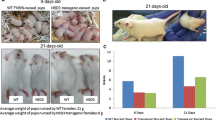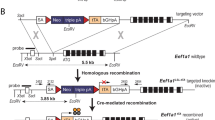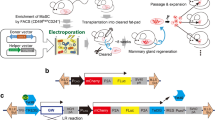Abstract
The PEA3 group members PEA3, ER81 and ERM, which are highly conserved transcription factors from the Ets family, are over-expressed in metastatic mammary tumors. In the current study, we present the characterization of a transgenic mouse strain which over-expresses ER81 in the mammary gland via the long terminal repeat of the mouse mammary tumor virus (LTR-MMTV). Although six genotypically positive transgenic lines were identified, only one expressed the ectopic transcript with an exclusive expression in the lactating and late-pregnancy (18th day) mammary glands. No mammary tumor or mammary deregulation appeared after 2 years of ectopic ER81 expression following lactation. We then sought to identify ER81 target genes, and the urokinase plasminogen activator (uPA) and the stromelysin-1, two enzymes involved in extracellular matrix degradation, were found to be transcriptionally upregulated in lactating mammary glands over-expressing ER81. Since these enzymes are involved in metastasis, this murine model could be further used to enhance mammary cancer metastatic process by crossing these animals with mice carrying non-metastatic mammary tumors. We thus created a transgenic mouse model permitting the over-expression of a functionally active Ets transcription factor in the mammary gland without perturbing its development.
Article PDF
Similar content being viewed by others
Avoid common mistakes on your manuscript.
References
Arber S, Ladle DR, Lin JH, Frank E and Jessell TM (2000) ETS gene Er81 controls the formation of functional connections between group Ia sensory afferents and motor neurons. Cell 101: 485–498.
Baert JL, Monté D, Musgrove EA, Albagli O, Sutherland RL and de Launoit Y (1997) Expression of the PEA3 group of Ets-related transcription factors in human breast cancer cells. Int J Cancer 70: 590–597.
Bouchard L, Lamarre L, Tremblay PJ and Jolicoeur P (1989) Stochastic appearance of mammary tumors in transgenic mice carrying the MMTV/c-neu oncogene. Cell 57: 931–936.
Brown TA and McKnight SL (1992) Specificities of protein-protein and protein-DNA interaction of GABPα and two newly defined ets-related proteins. Genes Dev 6: 2502–2512.
Busso N, Huarte J, Vassalli JD, Sappino AP and Belin D (1989) Plasminogen activators in the mouse mammary gland. Decreased expression during lactation. J Biol Chem 264: 7455–7457.
Buttice G, Duterque-Coquillaud M, Basuyaux JP, Carrere S, Kurkinen M and Stehelin D (1996) Erg, an Ets-family member, differentially regulates human collagenase1 (MMP1) and stromelysin1 (MMP3) gene expression by physically interacting with the Fos/Jun complex. Oncogene 13: 2297–2306.
Callahan R and Smith GH (2000) MMTV-induced mammary tumorigenesis: gene discovery, progression to malignancy and cellular pathways. Oncogene 19: 992–1001.
Chotteau-Lelièvre A, Desbiens X, Pelczar H, Defossez PA and de Launoit Y (1997) Differential expression patterns of the PEA3 group transcription factors through murine embryonic development. Oncogene 15: 937–952.
Chotteau-Lelièvre A, Dollé P, Coutte L, Peronne V, de Launoit Y and Desbiens X (2001) Expression patterns of PEA3 group members in early stages of mouse development. Mech Dev 108: 191–195.
Coutte L, Monte D, Imai K, Pouilly L, Dewitte F, Vidaud M et al. (1999) Characterization of the human and mouse ETV1/ER81 transcription factor genes: role of the two alternatively spliced isoforms in the human. Oncogene 18: 6278–6286.
Crawford HC, Fingleton B, Gustavson MD, Kurpios N, Wagenaar RA, Hassell JA et al. (2001) The PEA3 subfamily of Ets transcription factors synergizes with beta-catenin-LEF-1 to activate matrilysin transcription in intestinal tumors. Mol Cell Biol 21: 1370–1383.
de Launoit Y, Baert JL, Chotteau A, Monté D, Defossez PA, Coutte L et al. (1997) Structure–function relationships of the PEA3 group of Ets-related transcription factors. Biochem Mol Med 61: 127–135.
de Launoit Y, Audette M, Pelczar H, Plaza S and Baert JL (1998) The transcription of the intercellular adhesion molecule-1 is regulated by Ets transcription factors. Oncogene 16: 2065–2073.
de Launoit Y, Chotteau-Lelievre A, Beaudoin C, Coutte L, Netzer S, Brenner C et al. (2000) The PEA3 group of ETS-related transcription factors. Role in breast cancer metastasis. Adv Exp Med Biol 480: 107–116.
Fort P, Marty L, Piechaczyk M, El Sabrouty S, Dani C, Jeanteur P et al. (1985) Various rat adult tissues express only one major mRNA species from the glyceraldehyde-3-phosphate-dehydrogenase multigenic family. Nucl Acids Res 13: 1431–1442.
Higashino F, Yoshida K, Noumi T, Seiki M and Fujinaga K (1995) Ets-related protein E1A-F can activate three different matrix metalloproteinase gene promoters. Oncogene 10: 1461–1463.
Holst-Hansen C, Johannessen B, Hoyer-Hansen G, Romer J, Ellis V and Brunner N (1996) Urokinase-type plasminogen activation in three human breast cancer cell lines correlates with their in vitro invasiveness. Clin Exp Metast 14: 297–307.
Jeon IS, Davis JN, Braun BS, Sublett JE, Roussel MF, Denny CT et al. (1995) A variant Ewing's sarcoma translocation (7;22) fuses the EWS gene to the ETS gene ETV1. Oncogene 10: 1229–1234.
Karim FD, Urness LD, Thummel CS, Klemsz MJ, McKercher SR, Celada A et al. (1990) The ETS-domain: a new DNA-binding motif that recognizes a purinerich core DNA sequence. Genes Dev 4: 1451–1453.
Kaya M, Yoshida K, Higashino F, Mitaka T, Ishii S and Fujinaga K (1996) A single ets-related transcription factor, E1AF, confers invasive phenotype on human cancer cells. Oncogene 12: 221–227.
Leder A, Pattengale PK, Kuo A, Stewart TA and Leder P (1986) Consequences of widespread deregulation of the c-myc gene in transgenic mice: multiple neoplasms and normal development. Cell 45: 485–495.
Li F, Strange R, Friis RR, Djonov V, Altermatt HJ, Saurer S et al. (1994) Expression of stromelysin-1 and TIMP-1 in the involuting mammary gland and in early invasive tumors of the mouse. Int J Cancer 59: 560–568.
Li M, Lewis B, Capuco AV, Laucirica R and Furth PA (2000) WAP-TAg transgenic mice and the study of dysregulated cell survival, proliferation, and mutation during breast carcinogenesis. Oncogene 19: 1010–1019.
Lin JH, Saito T, Anderson DJ, Lance-Jones C, Jessell TM and Arber S (1998) Functionally related motor neuron pool and muscle sensory afferent subtypes defined by coordinate ETS gene expression. Cell 95: 393–407.
Lund LR, Bjorn SF, Sternlicht MD, Nielsen BS, Solberg H, Usher PA et al. (2000) Lactational competence and involution of the mouse mammary gland require plasminogen. Development 127: 4481–4492.
Monté D, Baert JL, Defossez PA, de Launoit Y and Stéhelin D (1994) Molecular cloning and characterization of human ERM, a new member of the ETS family closely related to mouse PEA3 and ER81 transcription factors. Oncogene 9: 1397–1406.
Monté D, Coutte L, Baert JL, Angeli I, Stéhelin D and de Launoit Y (1995) Molecular characterization of the Ets-related human transcription factor ER81. Oncogene 11: 771–779.
Muller WJ, Lee FS, Dickson C, Peters G, Pattengale P and Leder P (1990) The int-2 gene product acts as an epithelial growth factor in transgenic mice. EMBO J 9: 907–913.
Neznanov N, Man AK, Yamamoto H, Hauser CA, Cardiff RD and Oshima RG (1999) A single targeted Ets2 allele restricts development of mammary tumors in transgenic mice. Cancer Res 59: 4242–4246.
Schmitt M, Harbeck N, Thomssen C, Wilhelm O, Magdolen V, Reuning U et al. (1997) Clinical impact of the plasminogen activation system in tumor invasion and metastasis: prognostic relevance and target for therapy. Thromb Haemost 78: 285–296.
Sharrocks A, Brown AL, Ling Y and Yates PR (1997) The ETS-domain transcription factor family. Int J Biochem Cell Biol 29: 1371–1387.
Shimizu K, Ichikawa H, Tojo A, Kaneko Y, Maseki N, Hayashi Y et al. (1993) An ets-related gene, ERG, is rearranged in human myeloid leukemia with t(16;21) chromosomal translocation. Proc Natl Acad Sci USA 90: 10280–10284.
Stacey KJ, Fowles LF, Colman MS, Ostrowski MC and Hume DA (1995) Regulation of urokinase-type plasminogen activator gene transcription by macrophage colony-stimulating factor. Mol Cell Biol 15: 3430–3441.
Sternlicht MD, Lochter A, Sympson CJ, Huey B, Rougier JP, Gray JW et al. (1999) The stromal proteinase MMP3/stromelysin-1 promotes mammary carcinogenesis. Cell 98: 137–146.
Sympson CJ, Talhouk RS, Alexander CM, Chin JR, Clift SM, Bissell MJ (1994) Targeted expression of stromelysin-1 in mammary gland provides evidence for a role of proteinases in branching morphogenesis and the requirement for an intact basement membrane for tissue-specific gene expression. J CellBiol 125: 681–693.
Thomasset N, Lochter A, Sympson CJ, Lund LR, Williams DR, Behrendtsen O et al. (1998) Expression of autoactivated stromelysin-1 in mammary glands of transgenic mice leads to a reactive stroma during early development. Am J Pathol 153: 457–467.
Tremblay PJ, Pothier F, Hoang T, Tremblay G, Brownstein S, Liszauer A et al. (1989) Transgenic mice carrying the mouse mammary tumor virus ras fusion gene: distinct effects in various tissues. Mol Cell Biol 9: 854–859.
Trimble MS, Xin JH, Guy CT, Muller WJ and Hassell JA (1993) PEA3 is overexpressed in mouse metastatic mammary adenocarcinomas. Oncogene 8: 3037–3042.
Yamamoto H, Flannery ML, Kupriyanov S, Pearce J, McKercher SR and Henkel GW (1998) Defective trophoblast function in mice with a targeted mutation of Ets2. Genes Dev 12: 1315–1326.
Xin JH, Cowie A, Lachance P and Hassell JA (1992) Molecular cloning and characterization of PEA3, a new member of the Ets oncogene family that is differentially expressed in mouse embryonic cells. Genes Dev 6: 481–496.
Author information
Authors and Affiliations
Rights and permissions
About this article
Cite this article
Netzer, S., Leenders, F., Dumont, P. et al. Ectopic Expression of the Ets Transcription Factor ER81 in Transgenic Mouse Mammary Gland Enhances Both Urokinase Plasminogen Activator and Stromelysin-1 Transcription. Transgenic Res 11, 123–131 (2002). https://doi.org/10.1023/A:1015248525364
Issue Date:
DOI: https://doi.org/10.1023/A:1015248525364




